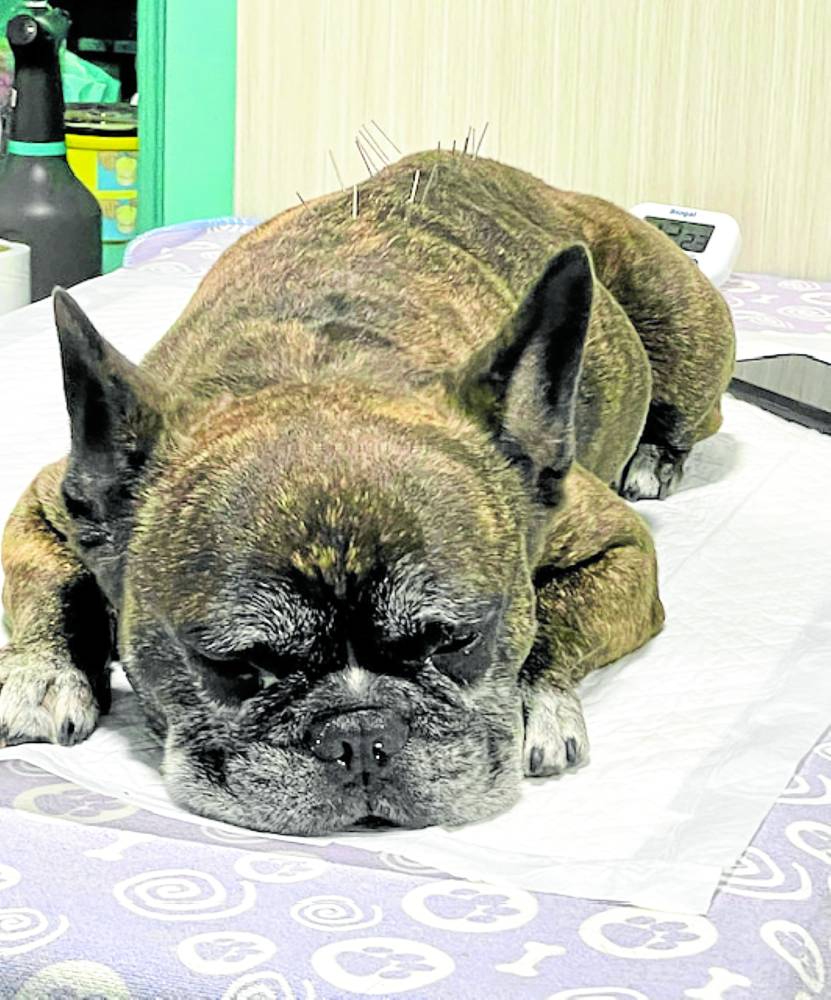
The practice dates back thousands of years. Fine needles are inserted into certain points of the body, after which these are stimulated either manually or with electricity. It has been observed to bring pain relief as well as reduce inflammation.
Some may view acupuncture, the ancient form of traditional Chinese medicine, as quack. But there are doctors who believe in the efficacy of the treatment for humans—and now even for pets.
Dr. Ging Berdon attests to the effectivity of acupuncture for small animals, which helped in the recovery of a cat that her team rescued from a fire.
“The cat had burns over more than 50 percent of his body,” recalled Berdon, medical director of Animal Kingdom Veterinary Hospital in Cebu.
“We stimulated acupuncture points because the cat was in severe pain. Eventually, after a few days, he started eating. That for me was like a miracle. I really thought that the cat would die.”
The cat was, of course, being given a ton of medicines, but Berdon also thinks that acupuncture was partly responsible for his healing because, according to her, the cat was just staring off into the distance already. “When we saw that look, we said, ‘Oh no, this cat might go anytime.’ But after a few days of continuous acupuncture, the cat just started moving around and eating.”
“It’s a very interesting concept,” said Berdon, who’s been practicing acupuncture for pets for over a decade now.
Berdon and Dr. Ed Unson, cofounder of Animal House Veterinary Hospital, both had acupuncture done on themselves—she, for chronic back pain, and he, for a knee injury—which piqued their interest in the treatment.
Shorter sessions
“I was really terrified at first, but the acupuncture gave me instant relief,” recalled Unson.
“It’s a little bit more difficult in dogs and cats. For one thing, they won’t sit, they won’t lie down in place for a long period of time, so the acupuncture sessions for animals are usually much shorter,” explained Berdon.
The theory, however, is essentially the same. Very, very thin needles are stuck into points on the body that correspond to certain nerves and organs. These needles are stimulated either by manually twisting them or by connecting them to a machine that sends electrical signals to the needles.
The needles encourage blood flow to the affected organ which, in turn, brings relief. If there’s inflammation, the increase in blood flow promotes the drainage of toxic materials and cells so pain and inflammation are lessened.
“In my practice, I see acupuncture as most beneficial to those with degenerative diseases, arthritis, leg injuries and mobility problems,” said Unson.
Both veterinarians are quick to emphasize that acupuncture is not to be viewed as an alternative treatment for sick pets. It is considered a holistic remedy which should be given regularly. Pet parents also need to realize that degenerative diseases and neurological issues do not completely heal. What acupuncture does is to manage the pet’s pain and slow down the progression of diseases.
“Acupuncture is not used as the main treatment. It’s used to complement standard medical treatment,” said Berdon.
She cites how they use acupuncture mostly for pain relief, especially for dogs with hip dysplasia. Hip dysplasia is a hereditary disease where the dog develops osteoarthritis in the hips at a very early age. This causes pain, limping and mobility problems.
“The standard treatment for this is long-term pain relievers. So this dog is taking pills all the time,” explained Berdon. “What acupuncture does is to help relieve the pain so that we can decrease the dose of pain relievers; instead of taking it daily, the dog can just have it every other day.”
Easing anxiety
This lessens the possibility of liver and kidney damage for pets, and the function of their vital organs is preserved for a longer period of time.
Acupuncture can also be used to ease anxiety in pets. It is beneficial, for instance, for pets who get extremely distressed when their fur parents are away for long periods of time.
“That’s one thing that many clients have told us, that after a session the pets are always happier, they respond more to their caretakers or their owners. And these dogs sleep really well afterward. They don’t wake up and pace around at night,” said Berdon.
Both Berdon and Unson get more dog patients than cats.
“If it’s cats, my God,” Berdon said with a laugh. “Just two minutes after sticking that needle in, wala na, the cat will want to run around na. It would jump. It’s almost impossible to do it. Unless we sedate them, but that’s not a very feasible idea.”
“Cats mask their pain, they hide their pain,” added Unson. “But we also get good results with cats.”
According to Unson, most pets even look forward to coming to the clinic for their acupuncture sessions. “Because they feel good afterward, so they know that it’s not a traumatic thing.”
He strongly advises pet owners to have a consultation first because it is important that their expectations are managed. “Kasi hindi ito isang tusok lang, magaling na. It’s a process.”
There are also certain diseases and conditions for which acupuncture is not advisable.
Pet owners need to know that one acupuncture session is not enough to get their pets immediately running around. Not all pets have the same response to the treatment, according to Unson. Both vets have encountered pet owners who got disappointed after just one treatment. It is done regularly, depending on the severity of the case.
“It’s not a miracle. It’s a combination of things—medicine, physical therapy, acupuncture—all of that together will work. So that’s the number one thing for fur parents to remember: Do not expect, do not set your expectations too high,” said Berdon.
“This is not magic,” she added with a laugh. “It’s done for a long period of time. It’s like maintenance, like giving your pet a bath every week. It’s not a one-time magic shot.”